How Human Mobility Models Can Help to Deal with COVID-19
Abstract
1. Introduction
2. Related Work
3. Mobility Models
3.1. Synthetic Models
3.2. Real Traces
3.3. Mobility Simulators
4. Generation of Scenarios
4.1. Basic Synthetic Scenarios
4.2. Plaza Scenario
4.3. Station Scenario
- People entering the Station. People enter the station through the doors of the main entrances. Specifically, for each of the four entrances, new pedestrians are generated according to a Poisson process with rate , entering the station and passing through the turnstiles located at the two ends of the station. Then, each pedestrian is randomly directed with equal probability to one of the four platforms.
- Arrival of trains. The arrival times of the train are generated with the values obtained from the measurements. When a train arrives, pedestrians wait on the corresponding platform, get on the train, and disappear from the PadSim simulation. At the same time, pedestrians get off the train and enter the platform. From this platform, and for each pedestrian, a station exit door is randomly selected. Then, the pedestrians go directly to the selected gate and leave the station.
- Pedestrian’s movement: As in the Plaza scenarios, the movement of pedestrians follows the social force model with an average speed in the range of 0.3–1.5 m/s.
5. Evaluation of the Scenarios
5.1. Temporal Evolution
5.2. Spatial Distribution
5.3. Physical Contacts Evaluation
- C: Number of Contacts. The whole number of generated contacts.
- P: Pairs Contacted. Number of different pairs of individuals that have contacted at least once.
- : Distribution of the accumulated duration of the contacts between pairs.
- : Average accumulated duration obtained as the average of the previous distribution.
6. Analysis of COVID-19 Transmission
6.1. Background
6.2. Exposure Risk Characterisation
7. Evaluation of the Infection Risk
7.1. ERV Evaluation
7.2. ERQ Evaluation
8. Conclusions
Author Contributions
Funding
Data Availability Statement
Conflicts of Interest
References
- Eames, K.; Keeling, M. Contact Tracing and Disease Control. Proc. Biol. Sci. R. Soc. 2004, 270, 2565–2571. [Google Scholar] [CrossRef]
- Salathé, M. Digital epidemiology: What is it, and where is it going? Life Sci. Soc. Policy 2018, 14, 1. [Google Scholar] [CrossRef] [PubMed]
- Singapore Government. Tracetogether. Available online: https://www.tracetogether.gov.sg (accessed on 15 April 2020).
- PePP-PT e.V. i.Gr. Pan-European Privacy-Preserving Proximity Tracing (PEPP-PT). Available online: https://www.pepp-pt.org (accessed on 15 September 2020).
- Hernández-Orallo, E.; Manzoni, P.; Calafate, C.T.; Cano, J. Evaluating How Smartphone Contact Tracing Technology Can Reduce the Spread of Infectious Diseases: The Case of COVID-19. IEEE Access 2020, 8, 99083–99097. [Google Scholar] [CrossRef]
- Hernández-Orallo, E.; Manzoni, P.; Calafate, C.T.; Cano, J. Evaluating the Effectiveness of COVID-19 Bluetooth-Based Smartphone Contact Tracing Applications. Appl. Sci. 2020, 10, 7113. [Google Scholar] [CrossRef]
- Zhang, X.; Neglia, G.; Kurose, J.; Towsley, D. Performance modeling of epidemic routing. Comput. Netw. 2007, 51, 2867–2891. [Google Scholar] [CrossRef]
- Helgason, Ó.; Kouyoumdjieva, S.T.; Karlsson, G. Opportunistic Communication and Human Mobility. IEEE Trans. Mob. Comput. 2014, 13, 1597–1610. [Google Scholar] [CrossRef]
- Prather, K.A.; Marr, L.C.; Schooley, R.T.; McDiarmid, M.A.; Wilson, M.E.; Milton, D.K. Airborne transmission of SARS-CoV-2. Science 2020, 370, 303–304. [Google Scholar]
- Nishiura, H.; Oshitani, H.; Kobayashi, T.; Saito, T.; Sunagawa, T.; Matsui, T.; Wakita, T.; Suzuki, M. Closed environments facilitate secondary transmission of coronavirus disease 2019 (COVID-19). medRxiv 2020. [Google Scholar] [CrossRef]
- Vukadinović, V.; Helgason, Ó.R.; Karlsson, G. An analytical model for pedestrian content distribution in a grid of streets. Math. Comput. Model. 2013, 57, 2933–2944. [Google Scholar] [CrossRef]
- Chancay-García, L.; Hernández-Orallo, E.; Manzoni, P.; Calafate, C.T.; Cano, J. Evaluating and Enhancing Information Dissemination in Urban Areas of Interest Using Opportunistic Networks. IEEE Access 2018, 6, 32514–32531. [Google Scholar] [CrossRef]
- Christaki, E. New technologies in predicting, preventing and controlling emerging infectious diseases. Virulence 2015, 6, 558–565. [Google Scholar] [CrossRef]
- Grossglauser, M.; Tse, D.N.C. Mobility increases the capacity of ad hoc wireless networks. IEEE/ACM Trans. Netw. 2002, 10, 477–486. [Google Scholar] [CrossRef]
- Chaintreau, A.; Hui, P.; Crowcroft, J.; Diot, C.; Gass, R.; Scott, J. Impact of Human Mobility on Opportunistic Forwarding Algorithms. IEEE Trans. Mob. Comput. 2007, 6, 606–620. [Google Scholar] [CrossRef]
- Garg, K.; Giordano, S.; Förster, A. A Study to Understand the Impact of Node Density on Data Dissemination Time in Opportunistic Networks. In Proceedings of the 2nd ACM Workshop on High Performance Mobile Opportunistic Systems HP-MOSys ’13, Barcelona, Spain, 3–8 November 2013; ACM: New York, NY, USA, 2013; pp. 9–16. [Google Scholar]
- Lin, Y.; Wang, X.; Zhang, L.; Li, P.; Zhang, D.; Liu, S. The impact of node velocity diversity on mobile opportunistic network performance. J. Netw. Comput. Appl. 2015, 55, 47–58. [Google Scholar] [CrossRef]
- Su, J.; Chin, A.; Popivanova, A.; Goel, A.; de Lara, E. User mobility for opportunistic ad-hoc networking. In Proceedings of the Mobile Computing Systems and Applications, Windermere, Cumbria, UK, 3 December 2004; pp. 41–50. [Google Scholar]
- Feng, Z.; Chin, K.W. A Unified Study of Epidemic Routing Protocols and Their Enhancements. In Proceedings of the 2012 IEEE 26th International Parallel and Distributed Processing Symposium Workshops & PhD Forum, Shanghai, China, 21–25 May 2012; IEEE Computer Society: Washington, DC, USA, 2012; pp. 1484–1493. [Google Scholar]
- Moreira, W.; Mendes, P. Impact of human behavior on social opportunistic forwarding. Ad Hoc Netw. 2015, 25 Pt B, 293–302. [Google Scholar] [CrossRef]
- Zhang, Y.; Zhao, J. Social Network Analysis on Data Diffusion in Delay Tolerant Networks. In Proceedings of the Tenth ACM International Symposium on Mobile Ad Hoc Networking and Computing (Mobihoc’09), New Orleans, LA, USA, 18–21 May 2009; ACM: New York, NY, USA, 2009; pp. 345–346. [Google Scholar]
- Herrera-Tapia, J.; Förster, A.; Hernández-Orallo, E.; Udugama, A.; Tomas, A.; Manzoni, P. Mobility as the Main Enabler of Opportunistic Data Dissemination in Urban Scenarios; Springer International Publishing: Cham, Switzerland, 2017; pp. 107–120. [Google Scholar]
- Bettstetter, C. Topology Properties of Ad Hoc Networks with Random Waypoint Mobility. SIGMOBILE Mob. Comput. Commun. Rev. 2003, 7, 50–52. [Google Scholar] [CrossRef]
- Bell, J.; Bianconi, G.; Butler, D.; Crowcroft, J.; Davies, P.C.W.; Hicks, C.; Kim, H.; Kiss, I.Z.; Lauro, F.D.; Maple, C.; et al. Beyond Covid-19: Network Science And Sustainable Exit Strategies. arXiv 2020, arXiv:2009.12968. [Google Scholar]
- Cevik, M.; Marcus, J.; Buckee, C.; Smith, T. SARS-CoV-2 Transmission Dynamics Should Inform Policy. SSRN 2020. [Google Scholar] [CrossRef]
- Chaw, L.; Koh, W.C.; Jamaludin, S.A.; Naing, L.; Alikhan, M.F.; Wong, J. SARS-CoV-2 transmission in different settings: Analysis of cases and close contacts from the Tablighi cluster in Brunei Darussalam. medRxiv 2020. [Google Scholar] [CrossRef]
- Cheng, H.Y.; Jian, S.W.; Liu, D.P.; Ng, T.C.; Huang, W.T.; Lin, H.H.; Team, T.C.O.I. Contact Tracing Assessment of COVID-19 Transmission Dynamics in Taiwan and Risk at Different Exposure Periods Before and After Symptom Onset. JAMA Intern. Med. 2020, 180, 1156–1163. [Google Scholar] [CrossRef]
- Buonanno, G.; Morawska, L.; Stabile, L. Quantitative assessment of the risk of airborne transmission of SARS-CoV-2 infection: Prospective and retrospective applications. Environ. Int. 2020, 145, 106112. [Google Scholar] [CrossRef]
- Buonanno, G.; Stabile, L.; Morawska, L. Estimation of airborne viral emission: Quanta emission rate of SARS-CoV-2 for infection risk assessment. Environ. Int. 2020, 141, 105794. [Google Scholar] [CrossRef]
- Peng, Z.; Jimenez, J.L. Exhaled CO2 as COVID-19 infection risk proxy for different indoor environments and activities. medRxiv 2020. [Google Scholar] [CrossRef]
- Jimenez, J.L. COVID-19 Aerosol Transmission Estimator. Available online: https://tinyurl.com/covid-estimator (accessed on 25 September 2020).
- Mittal, R.; Meneveau, C.; Wu, W. A mathematical framework for estimating risk of airborne transmission of COVID-19 with application to face mask use and social distancing. Phys. Fluids 2020, 32, 101903. [Google Scholar] [CrossRef]
- Keeling, M.J.; Rohani, P. Modeling Infectious Diseases in Humans and Animals; Princenton University Press: Princeton, NJ, USA, 2008. [Google Scholar]
- Sun, Z.; Di, L.; Sprigg, W.; Tong, D.; Casal, M. Community venue exposure risk estimator for the COVID-19 pandemic. Health Place 2020, 66, 102450. [Google Scholar] [CrossRef]
- Aleta, A.; Moreno, Y. Evaluation of the potential incidence of COVID-19 and effectiveness of containment measures in Spain: A data-driven approach. BMC Med. 2020, 18, 157. [Google Scholar] [CrossRef]
- Muller, S.A.; Balmer, M.; Neumann, A.; Nagel, K. Mobility traces and spreading of COVID-19. medRxiv 2020. [Google Scholar] [CrossRef]
- Cencetti, G.; Santin, G.; Longa, A.; Pigani, E.; Barrat, A.; Cattuto, C.; Lehmann, S.; Lepri, B. Using real-world contact networks to quantify the effectiveness of digital contact tracing and isolation strategies for Covid-19 pandemic. medRxiv 2020. [Google Scholar] [CrossRef]
- Dede, J.; Förster, A.; Hernández-Orallo, E.; Herrera-Tapia, J.; Kuladinithi, K.; Kuppusamy, V.; Manzoni, P.; bin Muslim, A.; Udugama, A.; Vatandas, Z. Simulating Opportunistic Networks: Survey and Future Directions. IEEE Commun. Surv. Tutor. 2018, 20, 1547–1573. [Google Scholar] [CrossRef]
- Bai, F.; Helmy, A. A Survey of Mobility Models in Wireless Adhoc Networks. In Wireless Ad Hoc and Sensor Networks; Springer: Berlin/Heidelberg, Germany, 2006; pp. 1–31. [Google Scholar]
- Gunes, M.; Wenig, M. Models for Realistic Mobility and Radio Wave Propagation for Ad Hoc Network Simulations. In Guide to Wireless Ad Hoc Networks; Springer: Berlin/Heidelberg, Germany, 2009; pp. 503–525. [Google Scholar]
- Karamshuk, D.; Boldrini, C.; Conti, M.; Passarella, A. Human mobility models for opportunistic networks. IEEE Commun. Mag. 2011, 49, 157–165. [Google Scholar] [CrossRef]
- Pirozmand, P.; Wu, G.; Jedari, B.; Xia, F. Human mobility in opportunistic networks: Characteristics, models and prediction methods. J. Netw. Comput. Appl. 2014, 42, 45–58. [Google Scholar] [CrossRef]
- Bettstetter, C.; Hartenstein, H.; Pérez-Costa, X. Stochastic Properties of the Random Waypoint Mobility Model. Wirel. Netw. 2004, 10, 555–567. [Google Scholar] [CrossRef]
- Mei, A.; Stefa, J. SWIM: A Simple Model to Generate Small Mobile Worlds. In Proceedings of the IEEE INFOCOM 2009, Rio de Janeiro, Brazil, 19–25 April 2009; IEEE: New York, NY, USA, 2009; pp. 2106–2113. [Google Scholar]
- Munjal, A.; Camp, T.; Navidi, W.C. SMOOTH: A simple way to model human mobility. In Proceedings of the 14th ACM International Conference on Modeling, Analysis and Simulation of Wireless and Mobile Systems (MSWiM’11), Miami, FL, USA, 31 October–4 November 2011; pp. 351–360. [Google Scholar]
- Munjal, A.; Navidi, W.C.; Camp, T. Steady-state of the SLAW mobility model. J. Commun. 2014, 9, 322–331. [Google Scholar] [CrossRef]
- Boldrini, C.; Passarella, A. HCMM: Modelling spatial and temporal properties of human mobility driven by users’ social relationships. Comput. Commun. 2010, 33, 1056–1074. [Google Scholar] [CrossRef]
- Ekman, F.; Keränen, A.; Karvo, J.; Ott, J. Working day movement model. In Proceeding of the 1st ACM SIGMOBILE Workshop on Mobility Models—Mobilitymodels ’08, Hong Kong, China, 27 May 2008; pp. 33–40. [Google Scholar]
- Hsu, W.J.; Spyropoulos, T.; Psounis, K.; Helmy, A. Modeling time-variant user mobility in wireless mobile networks. In Proceeding of the INFOCOM 2007 26th IEEE International Conference on Computer Communications, Barcelona, Spain, 6–12 May 2007; pp. 758–766. [Google Scholar]
- Yang, S.; Yang, X.; Zhang, C.; Spyrou, E. Using social network theory for modeling human mobility. IEEE Netw. 2010, 24, 6–13. [Google Scholar] [CrossRef]
- Ghosh, J.; Philip, S.J.; Qiao, C. Sociological orbit aware location approximation and routing (SOLAR) in MANET. Ad Hoc Netw. 2007, 5, 189–209. [Google Scholar] [CrossRef]
- Hui, P.; Chaintreau, A.; Scott, J.; Gass, R.; Crowcroft, J.; Diot, C. Pocket switched networks and human mobility in conference environments. In Proceedings of the 2005 ACM SIGCOMM Workshop on Delay-Tolerant Networking, Philadelphia, PA, USA, 26 August 2005; ACM: New York, NY, USA, 2005; pp. 244–251. [Google Scholar]
- Leguay, J.; Lindgren, A.; Scott, J.; Friedman, T.; Crowcroft, J. Opportunistic Content Distribution in an Urban Setting. In Proceedings of the 2006 SIGCOMM Workshop on Challenged Networks, (CHANTS ’06), Pisa, Italy, 11–15 September 2006; ACM: New York, NY, USA, 2006; pp. 205–212. [Google Scholar]
- Gaito, S.; Pagani, E.; Rossi, G. Fine-Grained Tracking of Human Mobility in Dense Scenarios. In Proceedings of the 6th Annual IEEE Communications Society Conference on Sensor, Mesh and Ad Hoc Communications and Networks Workshops, Rome, Italy, 22–26 June 2009; pp. 1–3. [Google Scholar]
- Eagle, N.; Pentland, A. Social serendipity: Mobilizing social software. Pervasive Comput. IEEE 2005, 4, 28–34. [Google Scholar] [CrossRef]
- Passarella, A.; Conti, M. Characterising aggregate inter-contact times in heterogeneous opportunistic networks. In Proceedings of the 10th international IFIP TC 6 conference on Networking–Volume Part II, Valencia, Spain, 9–13 May 2001; Springer: Berlin/Heidelberg, Germany, 2011; pp. 301–313. [Google Scholar]
- Hernández-Orallo, E.; Cano, J.C.; Calafate, C.T.; Manzoni, P. New approaches for characterizing inter-contact times in opportunistic networks. Ad Hoc Netw. 2016, 52, 160–172. [Google Scholar] [CrossRef]
- Zhu, H.; Li, M. Dealing with vehicular traces. In Studies on Urban Vehicular Ad-hoc Networks; Springer: Berlin/Heidelberg, Germany, 2013; pp. 15–21. [Google Scholar]
- Tsai, T.C.; Chan, H.H. NCCU Trace: Social-network-aware mobility trace. Commun. Mag. IEEE 2015, 53, 144–149. [Google Scholar] [CrossRef]
- University of Dartmouth. CRAWDAD Data Set. Downloaded. Available online: http://crawdad.cs.dartmouth.edu (accessed on 25 May 2020).
- Pajevic, L.; Karlsson, G. Characterizing opportunistic communication with churn for crowd-counting. In Proceedings of the 2015 IEEE 16th International Symposium on A World of Wireless, Mobile and Multimedia Networks (WoWMoM), Boston, MA, USA, 14–17 June 2015; pp. 1–6. [Google Scholar]
- Berrou, J.L.; Beecham, J.; Quaglia, P.; Kagarlis, M.A.; Gerodimos, A. Calibration and validation of the Legion simulation model using empirical data. In Pedestrian and Evacuation Dynamics 2005; Springer: Berlin/Heidelberg, Germany, 2007; pp. 167–181. [Google Scholar]
- Behrisch, M.; Bieker, L.; Erdmann, J.; Krajzewicz, D. SUMO–simulation of urban mobility: An overview. In Proceedings of the Third International Conference on Advances in System Simulation (ThinkMind) (SIMUL 2011), Barcelona, Spain, 23–29 October 2011. [Google Scholar]
- Gloor, C. PEDSIM—Pedestrian Crowd Simulation. Available online: http://pedsim.silmaril.org (accessed on 20 September 2020).
- Helbing, D.; Molnár, P. Social force model for pedestrian dynamics. Phys. Rev. E 1995, 51, 4282–4286. [Google Scholar] [CrossRef]
- Aschenbruck, N.; Ernst, R.; Gerhards-Padilla, E.; Schwamborn, M. BonnMotion: A Mobility Scenario Generation and Analysis Tool. In Proceedings of the 3rd International ICST Conference on Simulation Tools and Techniques, Torremolinos, Malaga, Spain, 15–19 March 2010; ICST: Brussels, Belgium, 2010; pp. 51:1–51:10. [Google Scholar]
- Hellewell, J.; Abbott, S.; Gimma, A.; Bosse, N.I.; Jarvis, C.I.; Russell, T.W.; Munday, J.D.; Kucharski, A.J.; Edmunds, W.J.; Sun, F.; et al. Feasibility of controlling COVID-19 outbreaks by isolation of cases and contacts. Lancet Glob. Health 2020, 8, e488–e496. [Google Scholar] [CrossRef]
- Ferretti, L.; Wymant, C.; Kendall, M.; Zhao, L.; Nurtay, A.; Abeler-Dorner, L.; Parker, M.; Bonsall, D.; Fraser, C. Quantifying SARS-CoV-2 transmission suggests epidemic control with digital contact tracing. Science 2020. [Google Scholar] [CrossRef] [PubMed]
- Kucharski, A. The Rules of Contagion; Profile Books: London, UN, 2020. [Google Scholar]
- European Centre for Disease Prevention and Control. Contact Tracing: Public Health Management of Persons, Including Healthcare Workers, Having Had Contact With Covid-19 Cases in the European Union–Second Update; Technical Report; ECDC: Stockholm, Sweden, 2020. [Google Scholar]
- CDC: Centers for Disease Control and Prevention. Coronavirus Disease 2019 (COVID 19): Public Health Guidance for Community-Related Exposure; National Center for Immunization and Respiratory Diseases (NCIRD), Division of Viral Diseases: 2020. Available online: https://www.cdc.gov/coronavirus/2019-ncov/lab/rt-pcr-panel-primer-probes.html (accessed on 23 October 2020).
- Pringle, J.C.; Leikauskas, J.; Ransom-Kelley, S.; Webster, B.; Santos, S.; Fox, H.; Marcoux, S.; Kelso, P.; Kwit, N. COVID-19 in a Correctional Facility Employee Following Multiple Brief Exposures to Persons with COVID-19. MMWR Morb. Mortal. Weekly Rep. 2020, 69, 1569–1570. [Google Scholar] [CrossRef] [PubMed]
- Apple. Configuring Exposure Notifications. Available online: https://developer.apple.com/documentation/exposurenotification/configuring_exposure_notifications (accessed on 23 October 2020).
- Still, G. Introduction to Crowd Science; CRC Press: Boca Raton, FL, USA, 2013. [Google Scholar]

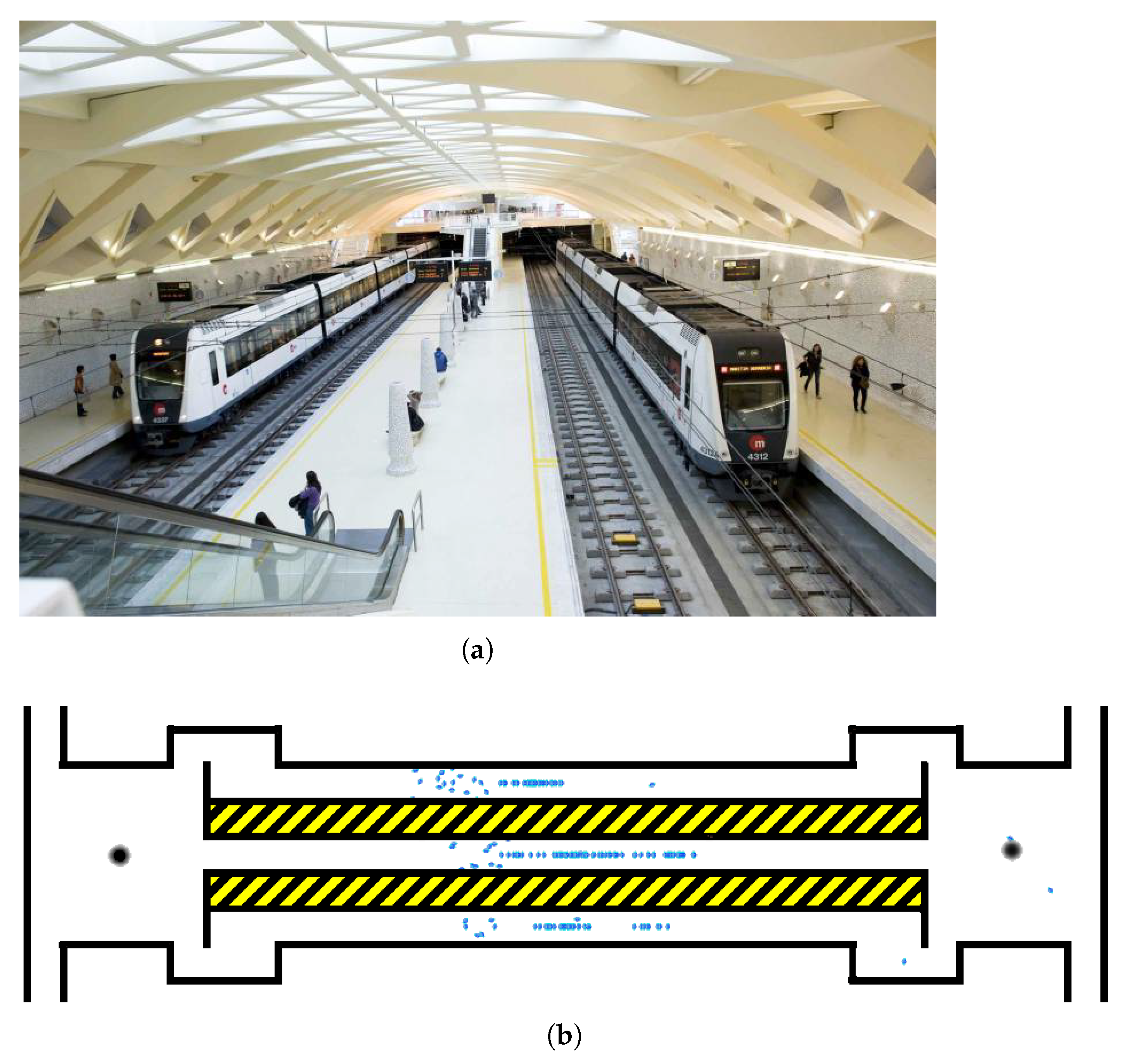
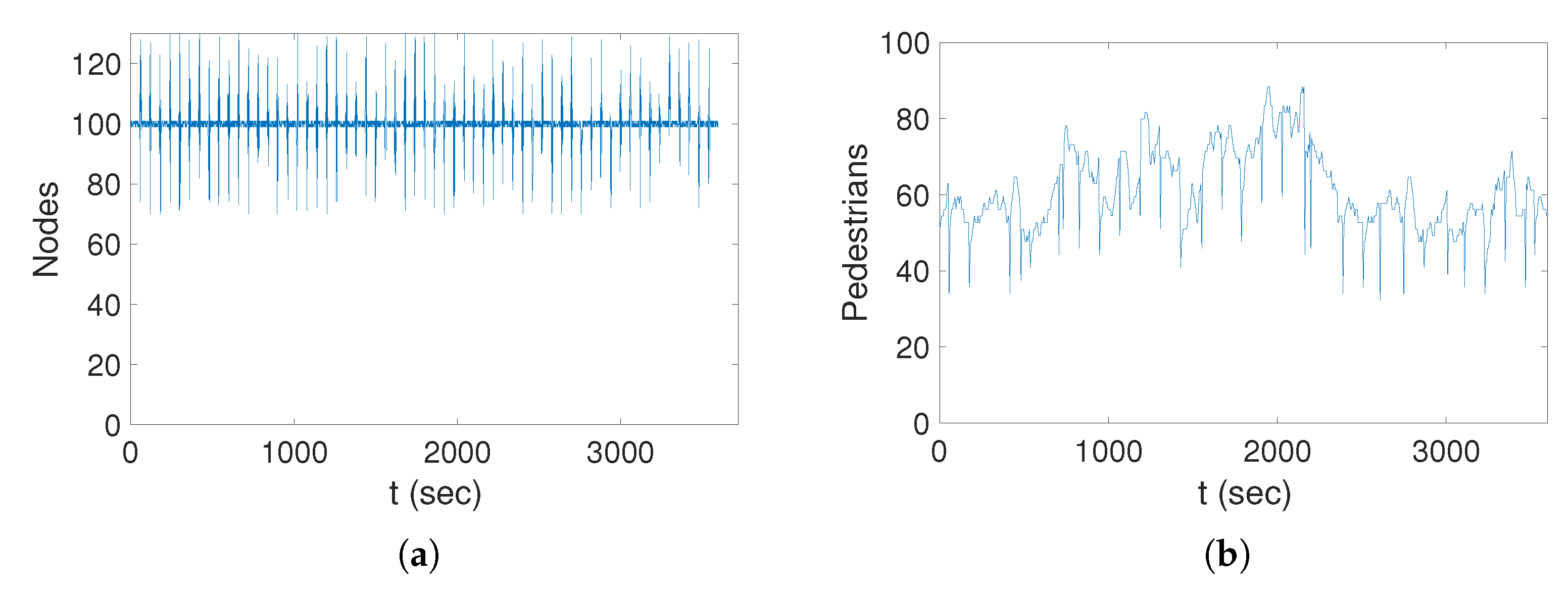


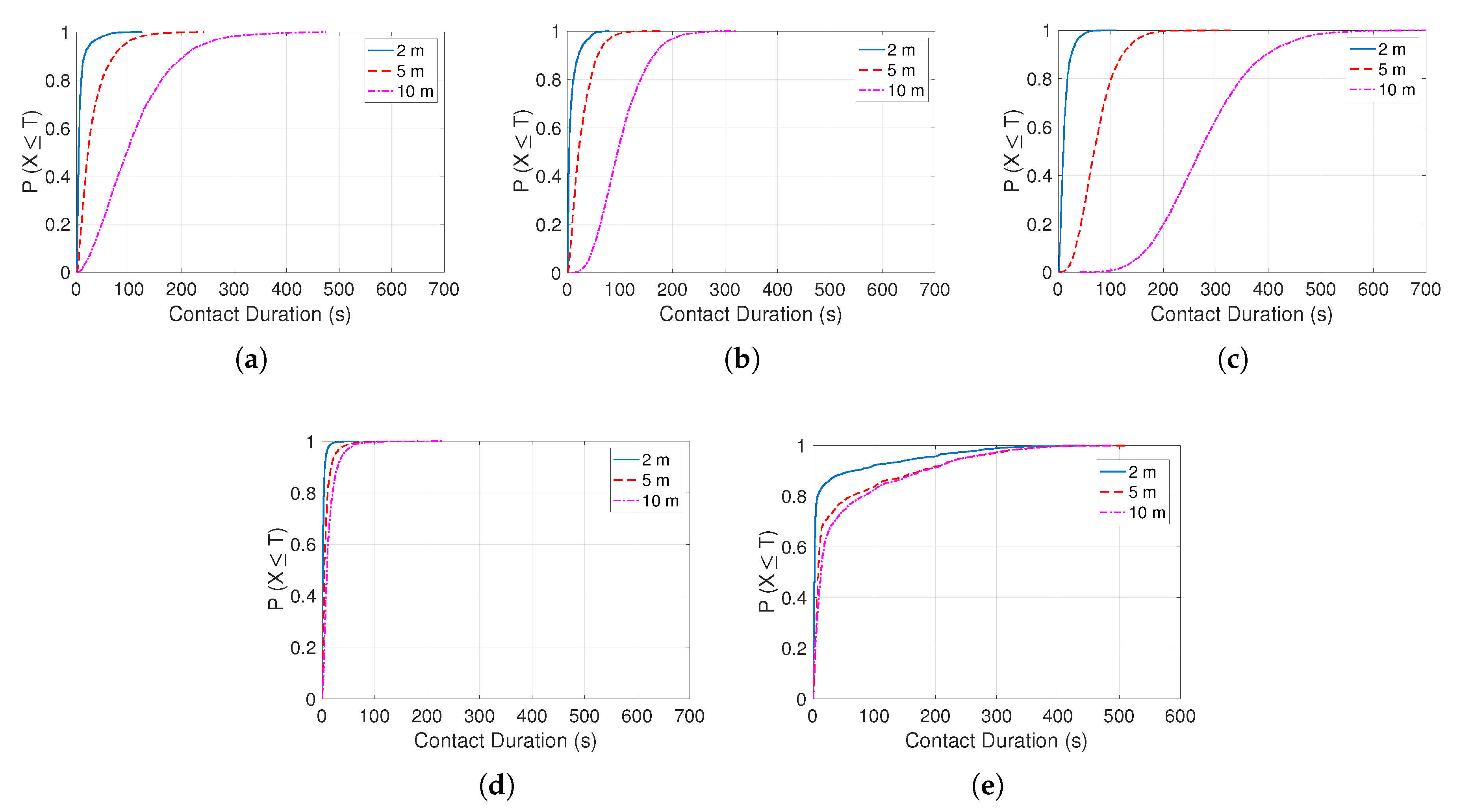

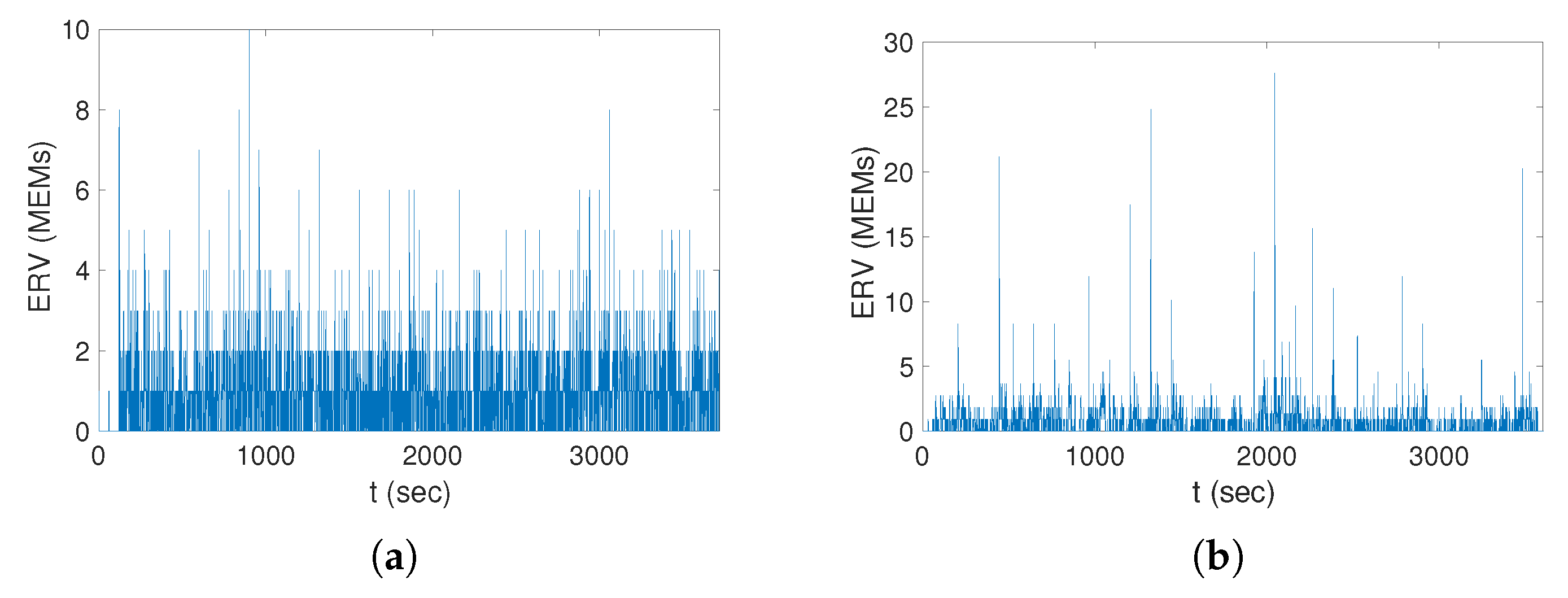
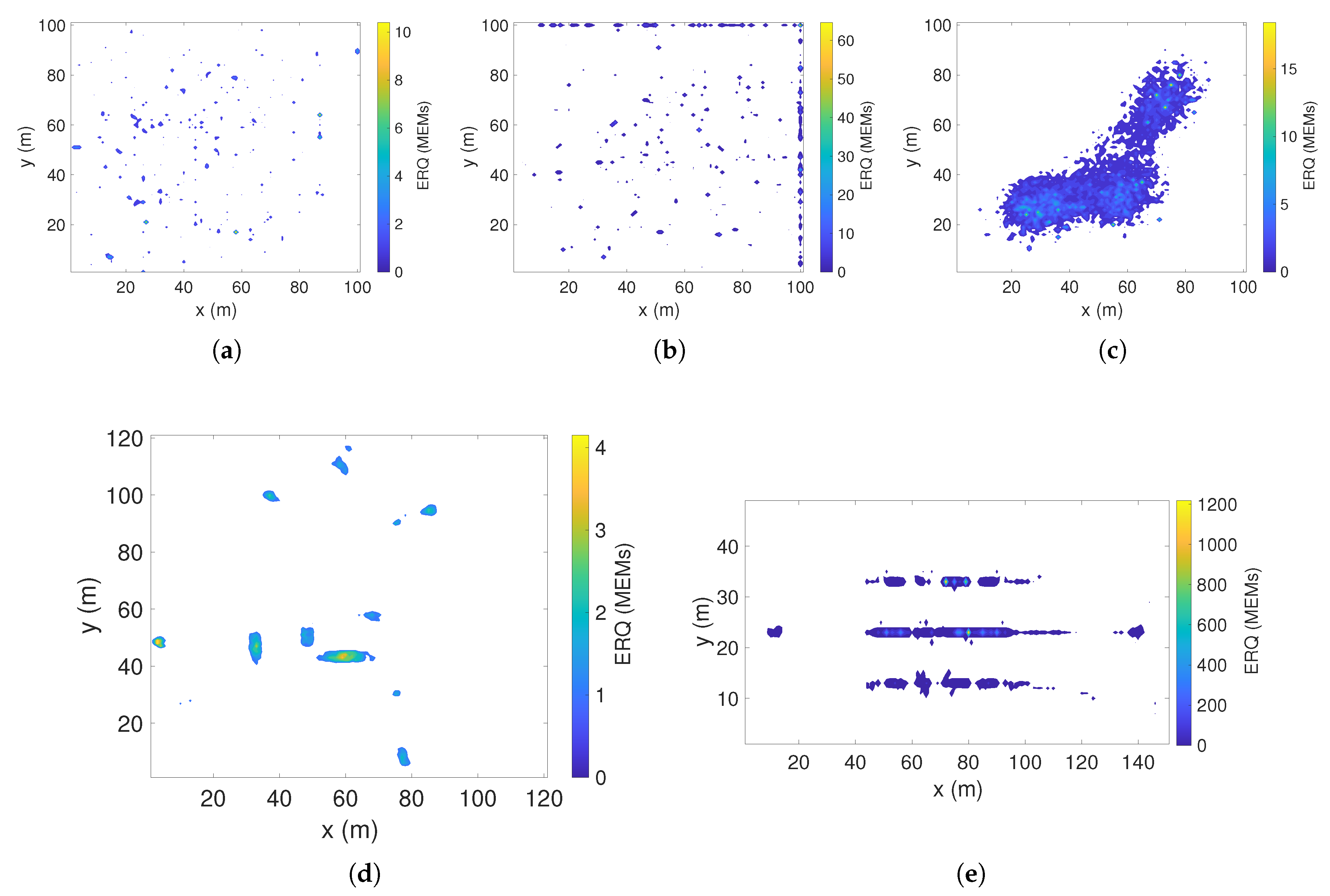
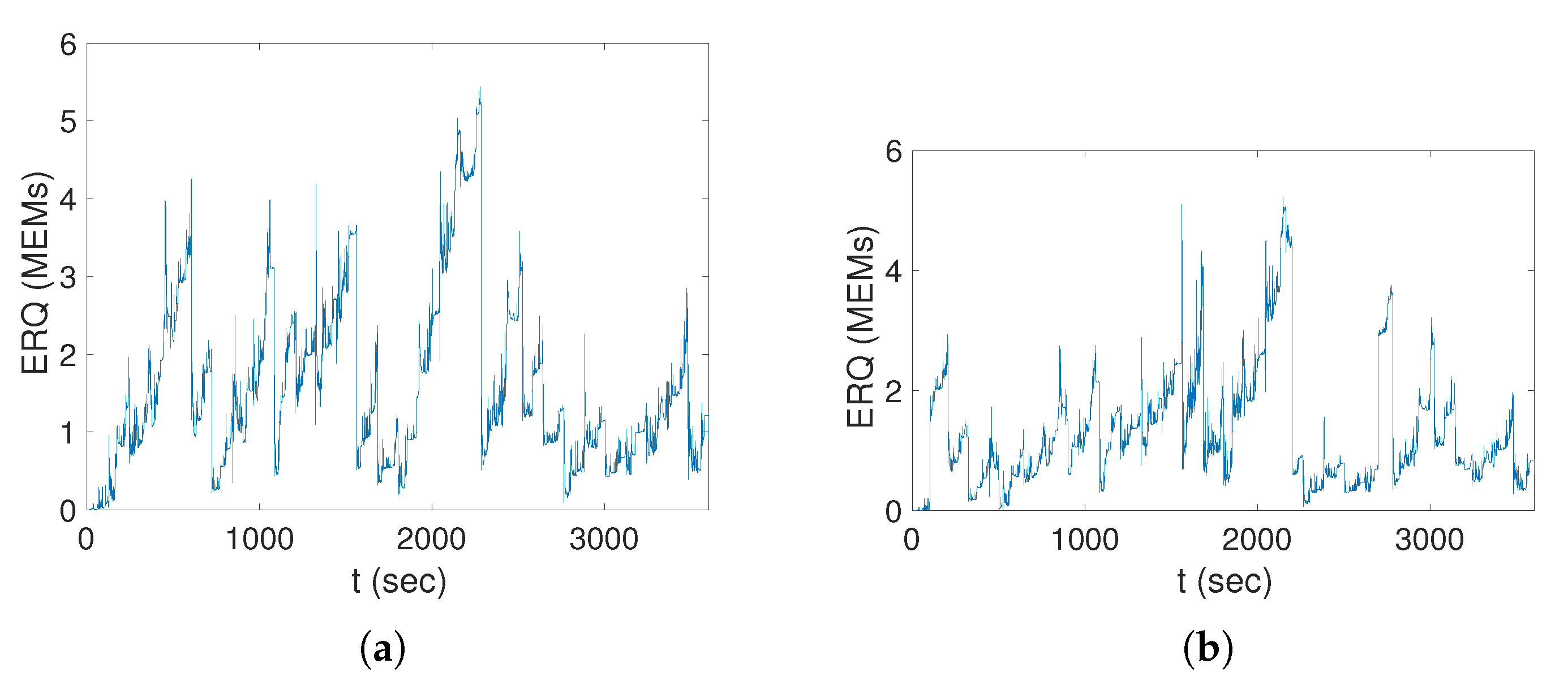

| Scenario | Nodes | Area | Other parameters |
|---|---|---|---|
| RWP | 100 | minSpeed = 0.5 m/s, maxSpeed = 1.5 m/s, maxPause = 60.0 s | |
| SWIM | 100 | nodeRadius = 0.2 m, cellDistanceWeight = 0.5 m, nodeSpeedMultiplier = 1.5, waitingTimeExponent = 1.55, waitingTimeUpperBound = 50.0 s | |
| RWPa | 100 | minSpeed = 0.5 m/s, maxSpeed = 1.5 m/s, maxPause = 60.0 s, attractionPoints = | |
| Plaza | 3050 | ||
| Station | 1485 |
| 2 m | 5 m | 10 m | |||||||
|---|---|---|---|---|---|---|---|---|---|
| Scenario | C | P | C | P | C | P | |||
| RWP | 9660 | 2784 | 7.6 | 24,222 | 4340 | 31.61 | 47,104 | 4883 | 108.9 |
| SWIM | 12,368 | 3436 | 7.8 | 62,624 | 4934 | 27.7 | 213,222 | 4950 | 102.2 |
| RWPa | 31,778 | 4739 | 12.4 | 78,692 | 4948 | 73.9 | 143,874 | 4950 | 277.7 |
| Plaza | 44,714 | 14,108 | 2.8 | 90,514 | 33,990 | 8.2 | 154,930 | 60,375 | 13.9 |
| Station | 5941 | 2632 | 21.9 | 7212 | 3682 | 43.1 | 14,324 | 5961 | 49.2 |
| Quality of the Medium | Good | Moderate | Bad |
|---|---|---|---|
| Air renewal | 1 | 2/3 | 1/3 |
| Temperature | 1 | 2/3 | 1/3 |
| Solar radiation | 1 | 2/3 | 1/3 |
| Value | 1 | 2/3 | 1/3 |
Publisher’s Note: MDPI stays neutral with regard to jurisdictional claims in published maps and institutional affiliations. |
© 2020 by the authors. Licensee MDPI, Basel, Switzerland. This article is an open access article distributed under the terms and conditions of the Creative Commons Attribution (CC BY) license (http://creativecommons.org/licenses/by/4.0/).
Share and Cite
Hernández-Orallo, E.; Armero-Martínez, A. How Human Mobility Models Can Help to Deal with COVID-19. Electronics 2021, 10, 33. https://doi.org/10.3390/electronics10010033
Hernández-Orallo E, Armero-Martínez A. How Human Mobility Models Can Help to Deal with COVID-19. Electronics. 2021; 10(1):33. https://doi.org/10.3390/electronics10010033
Chicago/Turabian StyleHernández-Orallo, Enrique, and Antonio Armero-Martínez. 2021. "How Human Mobility Models Can Help to Deal with COVID-19" Electronics 10, no. 1: 33. https://doi.org/10.3390/electronics10010033
APA StyleHernández-Orallo, E., & Armero-Martínez, A. (2021). How Human Mobility Models Can Help to Deal with COVID-19. Electronics, 10(1), 33. https://doi.org/10.3390/electronics10010033






